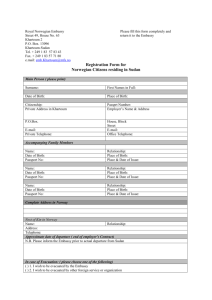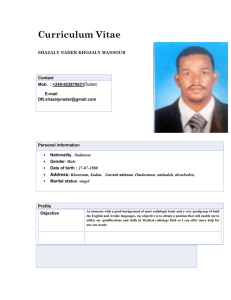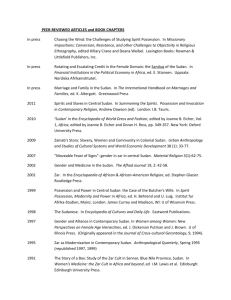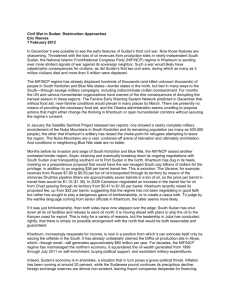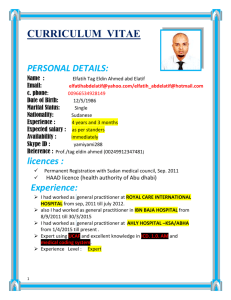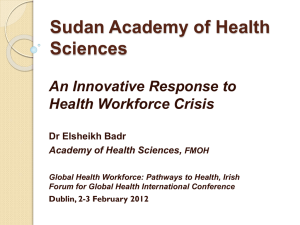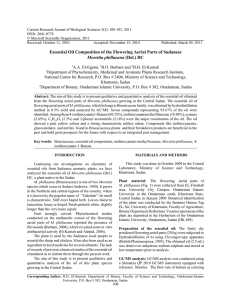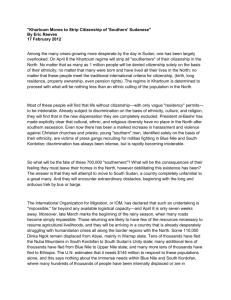FAMILY MEDICINE IN THE ARAB WORLD THE WAY AHEAD
advertisement
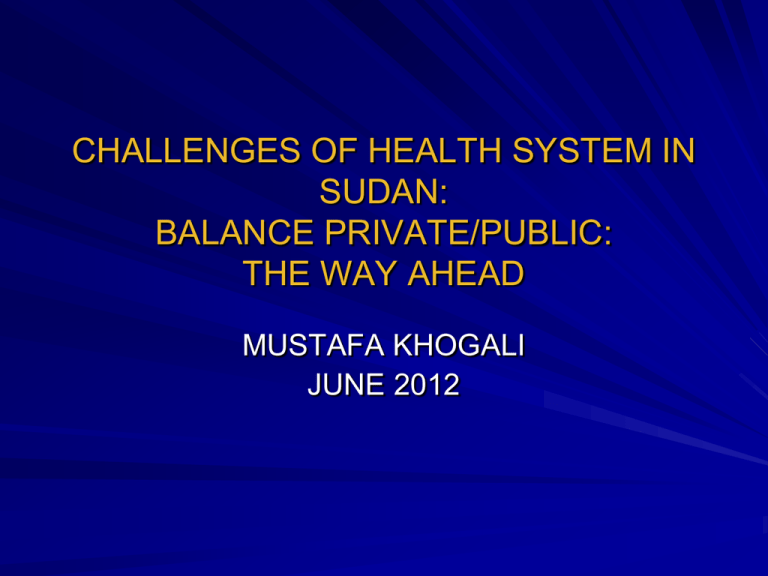
CHALLENGES OF HEALTH SYSTEM IN SUDAN: BALANCE PRIVATE/PUBLIC: THE WAY AHEAD MUSTAFA KHOGALI JUNE 2012 OUTLINE 1. Role of Health Systems 2. Health Status /Republic of Sudan (RS) 3. Status of Private Medical Sector since 1990 4. Major Health Challenges: Public / Private Overlap (Dual Practice) 5. The Way Ahead 6. Conclusion ARAB COUNTRIES (Map) POLITICAL MAP OF REPUBLIC OF SUDAN HEALTH SYSTEM Comprising of all organizations, institutions and resources that are devoted to produce health actions. Objectives: Improving H. of Popn Responding to people expectations Providing financial protection against the cost of ill health. MAJOR HEALTH CHALLNGES A Chronic Diseases Emerging Diseases Infectious/Endemic Diseases B H. Systems H. Services Delivery Human Resources in Health Public spending on health -DISPARITY HEALTH SYSTEMS DEVELOPMENT WORLDWIDE - 1920 Founding of Nat.H. Care Systems - 1970-80 – Promotion of PHC as a route to achieve universal coverage. (Success in Developed Countries) - 1990 More concerned with Demand. New Universalism. High Quality Delivery of Essential Care. HUMAN RESOURCE FOR HEALTH (HRH) HRH policies ---------- > improve HS performance HRH involved with both resource generation / service provision function It is crucial Issues: Education of Health Professionals Imbalance in workforce Migration Working conditions HEALTH CARE SERVICES Services depend on Health Care Workers Community Satisfaction HISTORY OF HEALTH CARE IN SUDAN 1899 Army 1904 Medical Department of N. Sudan 1905 Central Sanitary Board 1924 S M Services / Kitchener S M. 1924 (HWF: 16 British Doctors, 30 Syrian Doctors and 20 Sudanese Medical Assistants ) HISTORY OF HEALTH CARE IN SUDAN 1951 1960 1971 1979 1980 1991 Local Government Act. Province Administrative Act. Popular Governance Rule. Authorities' of M of H (Provinces). Local Govt. Act (5 reg.ex KH) Adoption of Federal System. Population by Region/Hospitals/Beds (CBS 2011) Region Pop000 % Khart. 5274 17 Cen(G/WN) 5306 17 North(RN/N) 1819 06 E(RS/K/G) 4534 15 SE(Sen/BN) 2117 07 SW(NK/Sk) 4327 14 Darf(N/S/W) 7516 24 P/Hos 46 87 29 57 50 44 32 Beds 6546 3856 2095 3353 3491 3133 2529 % 26 15 08 13 14 13 10 SOC/ECON. INDICATORS Variable SDG(M) % 1-G D P 125757 2-Total Exp. H 9203 7.3 3- Govt. Exp. H 2525 2.0 4-Priv. Exp. H 6678 5.3 5-Out /Pocket Exp 6422 96.0 Per cap Exp = 2/Pop =297SDG =60 $ Current Numbers of Doctors In RS 2010 Housemen General Practitioners Registrars Specialist Ministry Others* Ministry Others* Ministry Others* Ministry Others* Total 3653 0 4113 50 1794 0 1586 526 11722 * Others Refer to categories registered in other than ministry e.g. private facilities source (FMOH, 2010) PRIVATE HEALTH CARE SYSTEM / MEDICAL EDUCATION Until 1990 5 Private Hospitals 4 Medical Schools (Khartoum1924, Gezira 1979, AUW 1990, Omdurman Islamia 1990). 2011 Private Hospitals and Diagnostic Centers: 190 Khartoum State: 102 PRIVATE HEALTH CARE SYSTEM / MEDICAL EDUCATION Medical Schools: 32 Khartoum: 19 (Private 14 and Governmental 5) All other States: 13 LIST OF MEDICAL SCHOOLS (KH. STATE) Private 1. Ahfad 2. Karari 3. Af AlAlamia 4. U. Tech. 5. UMST 6. K M S 7. ALRazi 8. ALWatania 9. ALRibat 10. Sud. I. U. 11. ALNeel 12. ALMogtarbeen 13. ALYarmouk 14.Om ALAhia LIST OF MEDICAL SCHOOLS (KH. STATE) Governmental 1. Khartoum 2. Alzeem AlAzhary 3. Omdurman Islamia 4. AlNeeleen 5. Bahri STATE MEDICAL SCHOOLS 1. ALGazera 1979 2. Kassala 1991 3. Kordofan 1991 4. AlFasher 1991 5. Shandi 1994 6. ALImam ALHadi 1995 7. Bakhat ALRuda 1997 8. ELGedaref 1997 STATE MEDICAL SCHOOLS 9. Dongola 10.Sennar 11. Wadi ALNeel 12. West Kordofan 13. Red Sea 1997 1997 1998 2007 2007 HISTORICAL PROSPECTIVE OF PRIVATE PRACTICE SINCE 1990 1. 1991 Users Fees for P H Facilities. 2. 1992 Macroeconomic Reforms ↓ Govt. expenditure. 3. 1994 Adoption of 26 States. 4. 1994 Social Health Insurance 5. 1998 Local Governmental Act (633 localities) and its impact on H Services. HISTORICAL PROSPECTIVE OF PRIVATE PRACTICE SINCE 1990 6. 2003 New Local Government Act (134 localities). 7. 2005 Restructuring Health System into three levels (Federal/ State/ Locality). 8. Comprehensive Peace Agreement PUBLIC/ PRIVATE OVERLAP P. Prov. Capture a significant share of H services delivery. Dual Practice : Combination of public sector Clinical work / Private Approach. (1) Conceptual (2) Descriptive (3) Impact on H Care System/ H Status. (4) Qualitative (5) Possible Interventions PUBLIC/ PRIVATE OVERLAP Dual Practice: Multiple health – related practices in the same or different sites. Public / Public Public / Private Private / Private It is worldwide spread Most Prominent in Developing Countries IMPACT OF DUAL PRACTICE 1. Predatory Behaviour: e.g. C S rates 2. 3. 4. 5. (46% Private, 16% Public) and MRI etc. Conflict of Interest Internal Brain Drain (Rural → Urban) Public to Private . Competition For Time Corruption in the health Sector / Outflow of Resources POSSIBLE INTERVENTIONS 1. Total Banning of DP 2.DP with restrictions. 3.DP without restrictions WHAT TO DO?? 1.Addressing the DP problem openly. 2.Improving working conditions. 3.Incentives. 4.Professional Value System 5.Peer Pressure. 6.Pressure from Users. 7.Recruitment Practice. 8.Regulating Private Practice. CONDITIONS OF SUCCESS Strong leadership at both governmental and syndicate levels. A PC structure at the national level. A national authority committed to PC: - Maintains focus on the vision through the organization - Manages the change process and adapts to the local dynamics - Creates professional incentives on merit and performance. - Enforce Regulations equitably Flexibility from professional associations and health insurance. CONCLUSION The tremendous variety of approaches to various aspects of DP throughout the World provides an opportunity for each nation to identify ALTERNATIVES suitable for its prevailing condition & current operations. Each country should take ADVANTAGE of knowledge derived from already existing experiences in other countries. HOPEFULLY SO ?!
